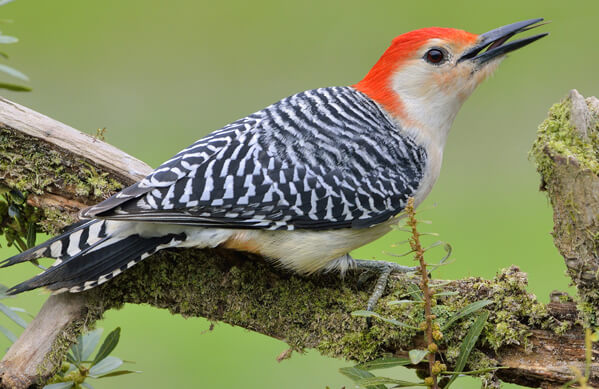Woodpeckers Unleashed: Exploring the Marvels of These Experienced Tree Mountain Climbers
Woodpeckers, with their unique markings and rhythmic drumming echoing via wooded areas, hold a special place in the avian globe. Their specialized composition and adaptations enable them to navigate upright surfaces with unmatched skill. Their mastery of tree climbing is just one facet of their fascinating behavior. As we delve right into the elaborate details of woodpeckers' nesting habits, feeding methods, and the ongoing preservation efforts to shield these amazing birds, a much deeper admiration for their location in nature unfolds.
Anatomy and Adaptations
When examining the anatomy and adjustments of woodpeckers, one can observe exceptional functions that enable these birds to grow in their specialized ecological particular niche. Woodpeckers are furnished with a suite of one-of-a-kind physiological characteristics that help them in their woodpecking behavior. One of one of the most noticeable functions is their solid, chisel-like beak, which is specialized for boring into wood to discover insects or create nesting dental caries. This beak is sustained by solid neck muscles and a very created head structure that serves as a shock absorber, permitting woodpeckers to continuously peck at trees without triggering mind injury. Additionally, woodpeckers have zygodactyl feet, with 2 toes dealing with ahead and two encountering backwards, supplying a company grip on tree trunks while they browse for food or drum for interaction.
Moreover, woodpeckers have an one-of-a-kind tongue structure that is long, barbed, and sticky, allowing them to draw out bugs from holes in wood. This customized adaptation allows woodpeckers to exploit a food resource that is inaccessible to many various other bird types. In general, the makeup and adjustments of woodpeckers showcase the exceptional transformative remedies that have actually enabled these birds to grow in their arboreal habitat.
Drumming Actions
Having actually discovered the makeup and adjustments of woodpeckers, the focus now moves to recognizing their drumming actions, a distinctive aspect of their communication and territorial screens. Drumming is a vital kind of communication amongst woodpeckers, serving several functions such as developing areas, bring in mates, and signaling alarm. Each woodpecker types has a special drumming pattern that aids people acknowledge members of their own species and identify them from rivals or killers.
Woodpeckers create drumming audios by rapidly pecking on powerful surface areas such as dead trees, utility poles, or also metal things, producing a series of balanced beats. The intensity and speed of drumming can vary based upon the objective; for circumstances, a fast drumming series might represent aggression towards burglars, while a slower and softer drumming pattern might show courtship (Woodpeckers in Florida). Additionally, woodpeckers might change the regularity and duration of their drumming to share specific messages properly
Nesting Routines
Discovering the nesting behaviors of woodpeckers exposes fascinating insights into their reproductive behaviors and environment options. Woodpeckers are understood for their distinct nesting choices, usually digging deep into dental caries in trees to produce sheltered spaces for raising their young. These tooth cavities serve not just as a nesting site but additionally as a safe and secure sanctuary from predators and inclement climate.
Woodpeckers show a high level of integrity to their nesting sites, often returning to the exact same location every year. This behavior highlights the significance of suitable environment schedule for their reproductive success. The selection of a nesting website is important for woodpeckers, with aspects such as tree types, elevation, and decay phase playing significant duties in their decision-making procedure.
Surprisingly, some woodpecker varieties are recognized to dig deep into numerous cavities within their this page territory, supplying themselves with alternative nesting alternatives. This technique might act as a form of insurance coverage versus prospective threats or disruptions to their main nesting site.

Feeding Techniques
Woodpeckers utilize a selection of specialized feeding methods to procure their main food sources. One of one of the most distinct feeding habits of woodpeckers is drumming, which entails rapid pecking on trees to uncover bugs below the bark. This drumming not just helps them find victim but also acts as a way of interaction with other woodpeckers. Woodpeckers have solid, chisel-like beaks that allow them to drill right into wood easily. When a hole is created, they utilize their long, barbed tongues to remove insects such as ants, beetles, larvae, and crawlers. These tongues are covered with sticky saliva that helps trap the find out this here target. Woodpeckers are likewise recognized to excavate cavities in trees to accessibility hidden insect larvae or sap. Some varieties, like the acorn woodpecker, shop nuts in specifically created holes called granaries. This strategic keeping of food aids them endure during food shortage durations. Woodpeckers are genuinely amazing in their feeding strategies, showcasing flexibility and knowledge in procuring their nutrition.
Conservation Efforts
In the middle of the intricate feeding techniques exhibited by woodpeckers, the conservation initiatives focused on securing these remarkable birds play a crucial role in protecting their environments and populations. Woodpeckers face various threats to their survival, consisting of environment loss because of logging, environment modification modifying their ecological communities, and crashes with man-made structures such as structures and lorries - Woodpeckers in Florida. Preservationists are actively functioning to deal with these difficulties and ensure the lasting health of woodpecker types

Education and learning and public awareness projects are additionally crucial elements of woodpecker preservation efforts. By elevating recognition about the significance of these birds in preserving healthy and balanced Continue woodland communities, guardians can amass support for habitat preservation initiatives and promote responsible land administration practices. Via collaborative initiatives in between researchers, policymakers, and neighborhood communities, we can work with each other to protect a future where woodpeckers flourish in their all-natural environments.
Verdict
